Homemade Mascarpone
Time and temperature are the secrets to a successful batch of mascarpone. Other than that all you have to work with are cream, some acid, a thermometer and a pan. Simple, right? Right…
The formula is one pint of heavy cream and one pint of half-and-half (all of it un-homogenized and un-stabilized if at all possible), which I have found gives a firmer texture than all cream (though that works too). As for the acid, you’ll need 1/4 teaspoon of tartaric acid (cream of tartar) OR 2 tablespoons of fresh lemon juice OR two tablespoons of white vinegar. Different people have different preferences, I like the powdered acid since it’s always reliable. The acidity of both lemons and vinegar, depending on the variety, can fluctuate.
Most mascarpone recipes begin with a double boiler because the heat is gentler. I prefer a small straight-sided saucepan. Yes, there is a risk of over-heating, however 1 quart of dairy isn’t much, and it tends to get lost inside a typical double boiler. It comes maybe one inch up the side of the pan, which makes it hard to get a reliable thermometer reading. A small pan gives me more depth, and as long as the pan is thick, very little risk of overheating. So then, pour your cream (or mix of cream and half-and-half) into the pan. Place it over medium-low heat.
I should insert, for those who might be inclined toward flavor infusions of some sort, that this is an excellent time to get busy. I can imagine a small cheesecloth bag containing perhaps citrus rinds, maybe spices or herbs, even coffee beans being dropped in at this point. Cream, because it is so full of fat, is a sponge for flavor.
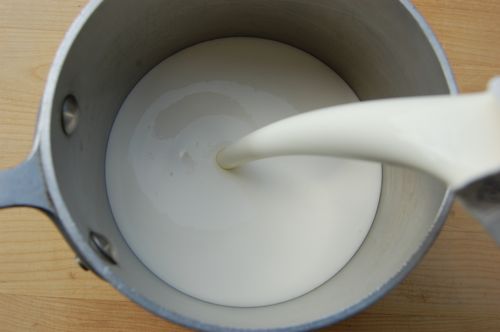
While the cream mixture is slowly coming up to temperature, mix your tartaric acid into about a tablespoon of water. Stir it up and keep it ready. If you’re planning on using a liquid acid, you can skip this step.
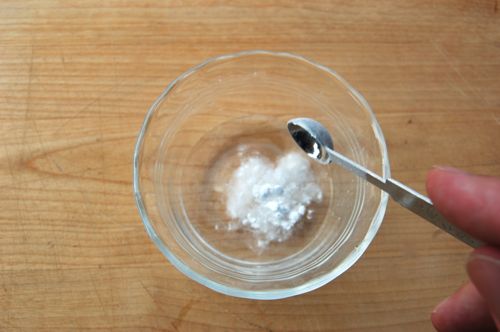
Now start watching your temperature closely. You’ll want to bring the mix up to temperature slowly, over the course of ten or fifteen minutes. Once it hits about 185…
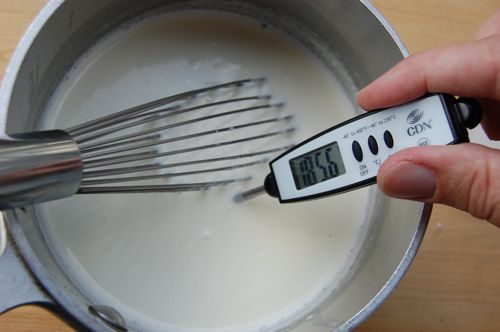
…give your acid mixture one last stir and pour it in.
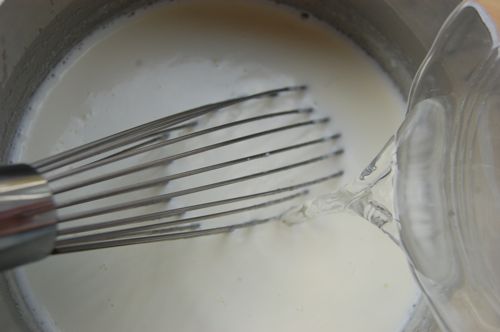
Begin to stir again. This will help the mixture curdle.
Now then, you want to maintain a temperature of right around 190 for about five minutes, until you see evidence that the acid is having an effect. What will that effect be, exactly? A slight thickening of your mixture. No, it won’t break into curds like other types of cheese mixtures will. However the thickness will tell you that your uncoiled proteins are starting to coagulate and interlock with one another, slowing the mixture’s flow. Instead of making lots of little curds (think ricotta or quark) it’s rather like, in fact it’s very like, in fact it’s exactly like, making a single large curd.
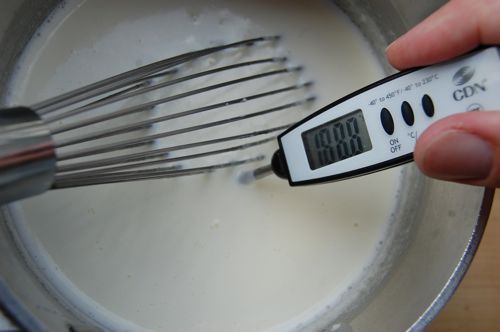
Keep stirring gently until…ah yes: there. About the thickness of a finished crème anglaise. See those little bulging waves? When you stir the mixture slowly, that’s what you’ll get. And no, those bubbles are not evidence of boiling, what you’re seeing is just some light foam the whisk created. For extra verification that you’ve reached the right point, remove the pan from the heat, insert a spoon, turn it over and run your finger down the back side. Does it make a clearly defined stripe? Then you’re done.

Set the pan aside and allow it to cool down to room temperature. This might be another prime opportunity, if you were so inclined, to introduce a flavoring in the form of an extract…if you wanted to…I’m just sayin’. Park it in the fridge for 24 hours. Yes, I drink Diet Coke. So what? I like the taste.
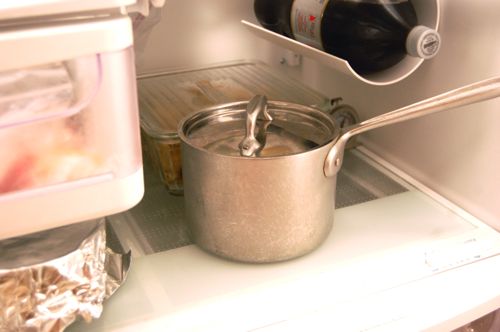
The next day, grab a medium-sized strainer or colander and set it in/over a pot or large bowl.
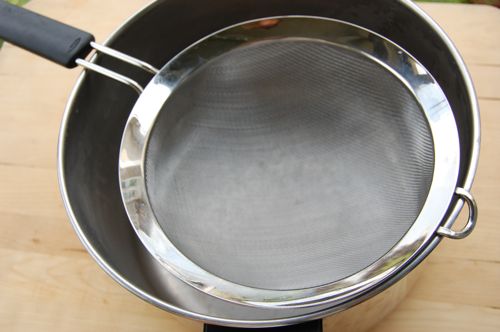
Line it with at least two layers of cheese cloth.
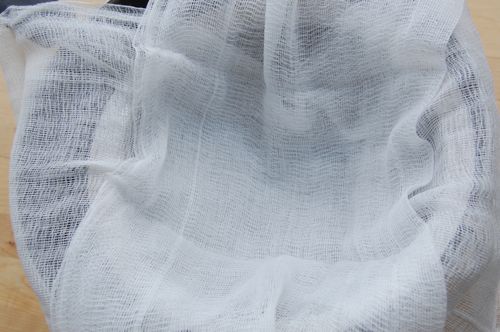
Take the pan out of the refrigerator and pour the mixture — which by now will be a good deal thicker — into the strainer.
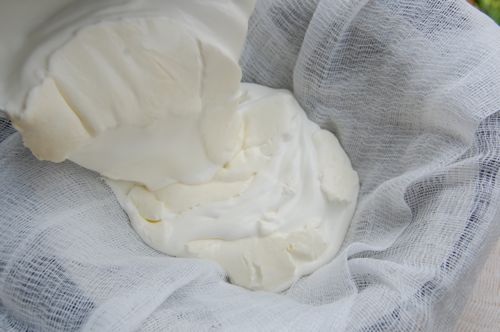
Don’t worry if the last of it seems rather runny, it still has a good deal of sitting yet to do. Return the cheese to the refrigerator, lightly covered with plastic wrap, for another 24 hours.
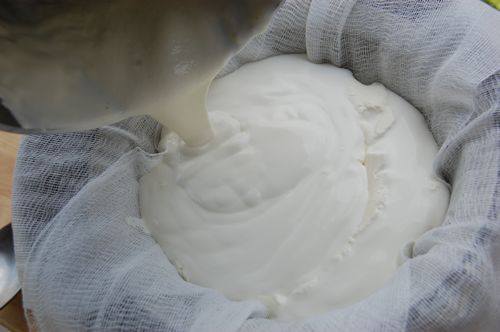
At the end of that period it will be thick, with a texture somewhere between sour cream and cream cheese.
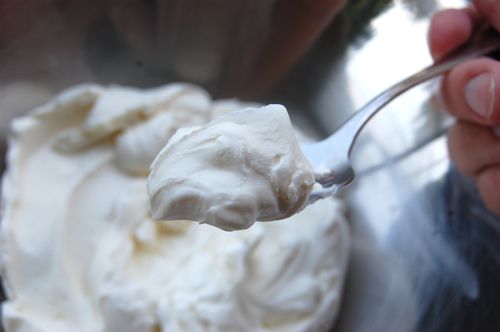
Oh and…here’s a quiz: what would you get if you employed this technique not with cream but with whole milk? Answer: paneer. And if you tried it with goat’s milk? Answer: goat cheese. Pretty cool.
Hi Joe,
Just wanted to let you know that after having success making ricotta cheese I had to make your mascarpone recipe…I am at the second 24 hour wait period and already it tastes sooo good…I have a question, how long will it keep in the fridge when it’s ready later today?
I won’t be using it until Sunday evening…that would be 4 full days.
Thanks very much,
Denise
It will last at least a week, probably longer if it’s kept in an airtight container. So glad it worked for you!
– Joe
Thanks for your quick response. I am having a difficult time disguising the bowl in the fridge from my husband who keeps begging for “just one more spoon, please”. It is divine, and works out to only 1/3 of the price of the store-bought.
One more question came to mind when I removed the strainer this afternoon to transfer the mascarpone to an airtight bowl, I discovered almost 2 cups of creamy “whey?” in the bowl below…I would hate to throw this away. Any suggestions what I can use it for? Thanks again Joe!
A lot of people (including myself) like to drink it over ice! Add a little sugar syrup to it if you wish…it’s a little like quark or kefir. A great smoothie base, too.
Hi Joe,
I’m hoping that with all the experience you have cooking you might be able to answer a question regarding making this. I live in Greece and the only cream I can get ( half and half doesn’t exist) is ultra-pasteurized. Any chance of it working? I have access to lots and lots of different kinds of yogurts, goat, sheep and cow, some even include and nice thick skin of fat on top and none if it is ultra-pasteurized. Anyway, I can find a way to make this with the ingredients I have access too?
Here’s hopin’
erica
Hi Erica! I don’t know very much about Greek dairying, I wish I did. My best suggestion is that you try it and see! You live in a great part of the world for microbes. Experiement a bit and get back to me. And if you want half and half, just make your own: 50% cream and 50% whole milk.
Erica,
I live in Greece too, and just to let you know there is only one double cream available from Volos Dairy Products(Evol) which has 45-50% fat. This will do the job. Tartaric acid on the other side was such a challenge to find it. I did at a pharmacy finally!
Hello Apostolos!
I’m very glad you found the missing ingredient! How did the mascarpone turn out?
– Joe
Hi Joe!
What a revelation was your mascarpone recipe. I did it in Greece for the first time and it turned out great! Not to mention all the stunned looks of everyone who learned my tiramisu was made out of not only home made lady fingers but mascarpone as well!!! I used Evol double cream which is a great product , with a very short shelf life and more than 45% fat in it. No I’m in Moscow and I want to make it at my girlfriend’s house this time using 30% clifki which is how the call cream here! I will let you know about the results! Thanks for everything again!!
Do I ever love that story, Apostolos! Why yes, I DID make that mascarpone myself! 😉
But be grateful, the last time I was in Moscow they didn’t even have cream. Of course that was before the wall fell…
But yes please do let me know how it goes. I’ll be here! Cheers,
– Joe
Thanks for everything you share on your web. It is so useful for my baking. Today I made mascarpone like your post, but my mascarpone is little more sour than the other I buy. Can I still use it for making Tiramisu?
Yes! That extra tang will be delicious. Where do you live? I’m coming over.
– Joe
opps! It is my pleasure when you come over. But I live in Viet Nam, Asia, not in US. This is not easy for us to hang out, talk about pastry and dessert, taste dish and share experiment like I wish that.
I will give you picture of my baking which follow your recipe. I am not good at taking photograph ( like you), but I will try my best.
This is Japanese cheesecake ( cut the golden and crakcer top of cake) with homemade strawberry jam I made , post by my Fiancee’s facebook
http://www.facebook.com/photo.php?fbid=493139747376485&set=pb.100000413917232.-2207520000.1354427288&type=3&src=http%3A%2F%2Fsphotos-g.ak.fbcdn.net%2Fhphotos-ak-snc7%2F315667_493139747376485_425915706_n.jpg&size=717%2C960
I was joking, but I do love cheesecake! Your photo is beautiful. Thank you for he comment!
– Joe
I made your recipe joe with UHT cream since that is all I could find and it turned out perfect
Sorry I pressed ‘send’ before I could finish typing. Wanted to say thanks for the tutorial. Thanks so much for all the instructions and pics. I got it right the first time and I owe that to you.
Glad to hear the success story, Lorraine, and it is indeed my great pleasure! I love what I do….
– Joe
thx for the recipe i work in a restaurant where mascarpone is bought out a company now i started making it with this recipe and it is great. after the holding at 190 i poured it into a differrent similar size pan to store with vanilla paste and sugar already on the pan after the holding and before t he 24hour mark and infused greatly i got great oaky sweet vanilla tast with a silky smooth and flawless texture. i use it to garnish french toast but now people ask for it for toast and even on pancakes like if it was butter. now im goin crazy with the different things i cna infuse the mascarpone great recipe, great instructions. thanks again _eloy from seatle
Wonderful news, Eloy! Hats off to you for being so creative with it. Send me some pictures sometime…I’d love to see some of the ways you’re using it!
Cheers,
– Joe
Joe,
I was wondering how much this recipe yields. I need a lb at least for a tiramisu recipe.
Thank you so much!
Hi Omar! A pint is a pound the world around as they say, so it should give you more than a pound. You lose some of the volume to draining but you shouldn’t lose too much…I think you’re good!
Cheers,
– Joe
How do I do this with goats milk? Hard to get the cream from goats milk!
Good point!
Goat cream. Never really heard of that before. It will take some experimentation methinks. You can start by substituting goat milk for the milk that would be present in the half and half, know what I mean? Use a (cow) cream and goat milk mix instead of the half and half. You might be able to substitute goat milk for more of that portion of the recipe since goat milk is a little richer than cow milk. Added to that the fact that the fat in goat milk is more highly saturated so it will tend to make a firmer cheese.
Get back to me if you decide to try any of this!
Cheers,
– joe
Joe,
What would you recommend for someone who has a casein allergy? I’d rather not use any cow’s milk but solely goat’s milk? Is it still possible or will the consistency be completely different and unusable for tiramisu? I have perfected my recipe for tiramisu and now in the light of newly discovered food allergies have to amend it to be gluten-free, dairy-free. That’s quite a feat, isn’t it? Any suggestions?
Thank you!
Patti
Hey Patti!
I confess that’s not my area of specialty, but in theory goat milk would work. The trouble is: where do you get goat cream? I’ve never seen it and you need the higher-fat product. But there’s no reason it couldn’t work. In place of the lady fingers you could try some nut meringue of the kind I just used for Esterházy torte (just scroll down on the main page). Best of luck with the new creation! Let me know how it goes!
– Joe
You get goat cream from goat milk by useing a separator! I use the cream for making ice cream. And butter which makes the lightest, flakiest tart crust imaginable No goaty taste or aroma if make with fresh from the goat and used within a week.
It seems so obvious now that you say it, Barbara! Thanks!
– Joe